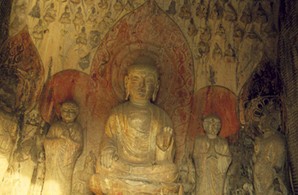
Longmen Grottoes were built around 493 A.D., about the time when Emperor Xiaowen of Northern Wei Dynasty moved the country's capital to Luoyang . Construction continued through several dynasties: Western Wei, Eastern Wei, Northern Qi, Sui, Tang and the period of Five Dynasties and Ten States. Within the 1000 meters long scenic area, there are over 100,000 statues in more than 2000 caves made over a period of over five centuries. Thousands of these sculptures and caves, preserved in the Yi and Que Mountains, were built at the height of construction during Northern Wei Dynasty and Tang Dynasty.
Guyang Cave, Mid-Binyang Cave, Lianhua Cave and Shikong Temple are representative of the caves and temples built during Northern Wei Dynasty. Guyang Cave contains a series of sculptures of some royal family members and ministers of the royal court after the capital had been moved to Luoyang. The sculptures in this cave demonstrated how dominant Buddhism was at that time. They are examples of the earliest Gandhara style grotto art in Luoyang: a fusion of traditional Chinese and foreign cultures.





